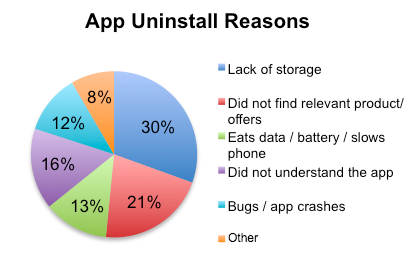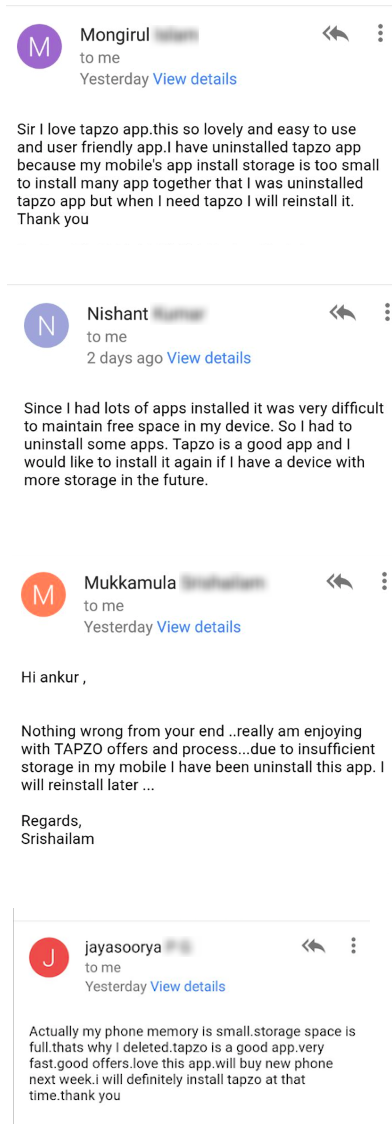One of the worst kept secrets of the mobile app industry is that almost all apps (except for the top 5-8 apps) see 60-80% uninstall rate within 90 days of users installing the app. India probably has the highest uninstall rate in the world – so when an app says it has 20M installs, you can do your math.
The big question is why?
We started digging deeper into this phenomenon and have interviewed more than 750+ people on their mobile habits over the last one year. These people were between 22-30 years old, predominantly males living in the top 5 cities in India.
Here is the split for reasons why Indians uninstall their apps:

While they may understand the other issues, the reason that most of the startup community – founders, investors, product managers etc.- don’t understand the storage issue well is that they mostly use high storage iPhones. If they use Android, the device of choice is OnePlus – again a high end phone with high storage.
Some anecdotal evidence
I send out a short and simple email asking every user who has uninstalled our app: “Why did you uninstall the Tapzo app?”
I read through all these emails diligently (even though sometimes I am unable to reply).
Lack of storage comes out as a big reason. Here are some sample replies:

While the answer for us is to keep improving the app (so that the user feels that Tapzo is one app he can’t remove), the mails just give you a sense of the problem.
Actually, the average Android user might see a screen like this 1-2 times a month whenever he tries to install new apps:

Another indicator: apps like CleanMaster scaled to 50M+ installs in India without spending much on acquisition because of helping users users clean up junk files/apps/images from their phones. For most commerce-based companies, that kind of customer acquisition would cost about $US70M! That’s the difference between push v. pull.
Why is storage such a big problem?
To understand things further, we also sampled 2,500,000 Android users to understand the extent of the problem. The average Indian’s smart phone costs Rs.6000-12000. The typical configuration at the lower end of this spectrum is a phone with a 8GB storage space.
Here’s the typical storage split of this 8GB storage space:

In a world where the Android OS and WhatsApp takes up almost 50% of the user’s phone space, even the Facebook app ends up being uninstalled: our research showed that while 97% of the users have the WhatsApp app, only 68% users have the Facebook app. If Facebook app is being uninstalled (of course, users use it through their mobile browsers), what hope do other apps have!
The problem is here to stay with us
There are upward and downward pressures on storage constraints in the phone:
Things that will alleviate the problem:
– Storage prices should drop over the next few years
– Some cloud storage services (like Google Pictures) will pick up and better UX for external storage will evolve
Things that will ensure that storage continues to be a problem:
– Our data showed an interesting paradox: the moment the user has more storage, a bigger chunk of it gets allocated to WhatsApp, videos and photos. Somehow, the amount of storage used for apps doesn’t increase that much (20% more for 2X space).
– 600M Indians on feature phones will first migrate to smart phones with limited storage capacities (<16GB).
So we are likely to see storage being a real problem for the Indian users for the next 5-6 years at least, if not more.
So, how does one reduce their app uninstall rate?
Unfortunately, it is difficult to manage this because your app is competing with a Sunny Leone video or pictures in their family WhatsApp groups.
But here are some (obvious) hacks:
– make something people want (most basic part – just explore the top 500 apps on the Google PlayStore to get a sense)
– get the first time user experience (FTUE) right
– allow for the app to work on an external SD card (easier said that done)
– keep the app size on disk super small
– do deep app indexing so that the chances are that user gets reminded about your app frequently enough to use it
– personalise notifications, your app etc. in the hope that it will lead to better engagement
– pray that when the user is cleaning up his phone, he forgets about your app. 🙂
————–
Some additional reading:
New data shows losing 80% of mobile users is normal, and why the best apps do better
What is considered a good or bad uninstall rate for a free Android app?

Leave a Reply